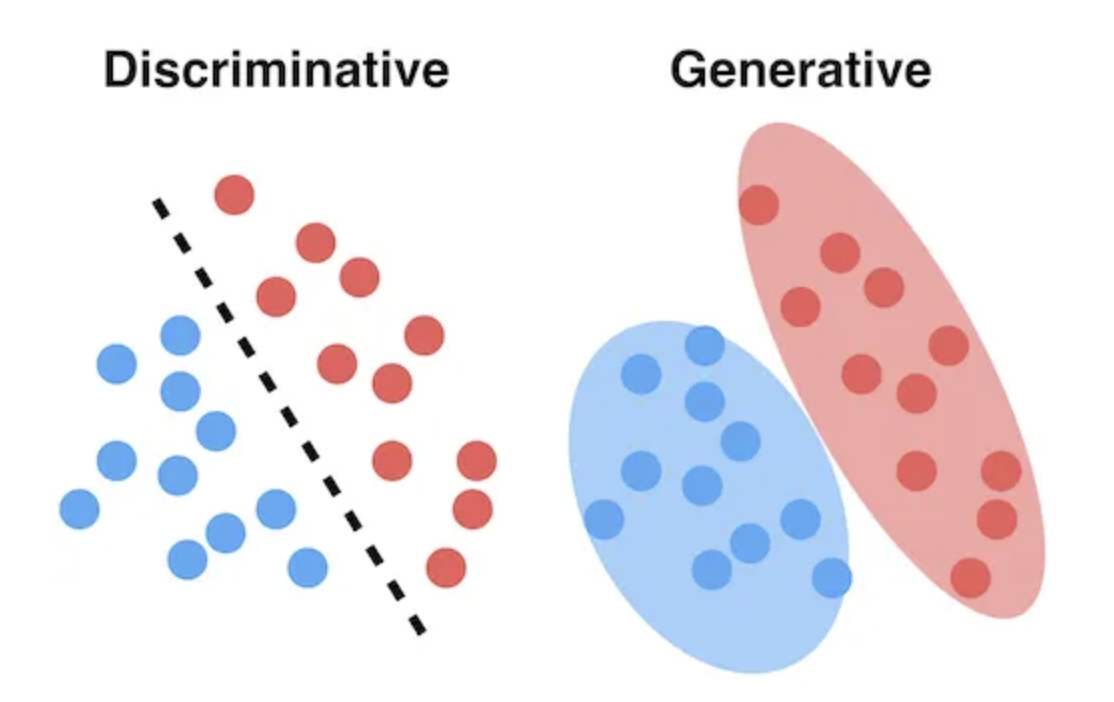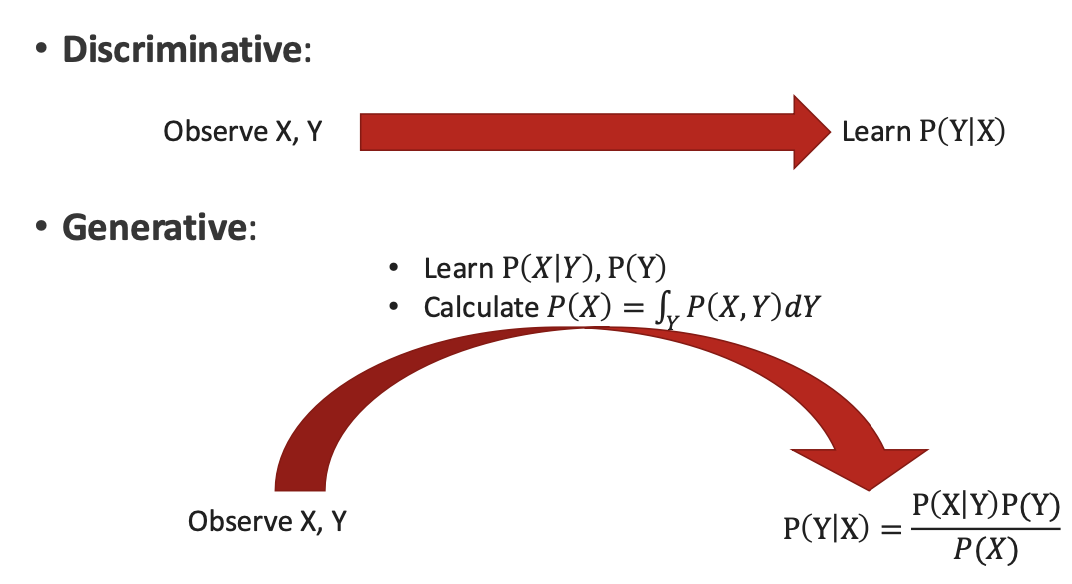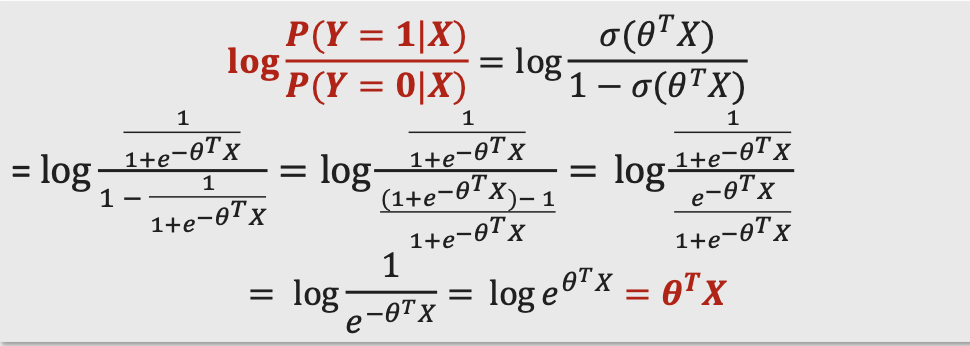Lecture 15
A Linear Intro to Generative Models
Today’s Topics:
- 1. Generative Models
- 2. Generative and Discriminative Models
- 3. Example Discriminative Model:Logistic Regression
- 4. Example Generative Model:Naive Bayes
- 5. Discriminative vs Generative Models
- 6. Logistic Regression vs Naive Bayes
- 7. Modern DGMs
1.Generative Models
Deep Generative Models (DGM)
Key Characteristics
- Previoulsy, we learned about discriminative model that can classify images (e.g., CNN).
- Now, we will learn generative models that not only classify images, but they can also generate them on their own - such as ChatGPT, Gemini or DeepSeek.

2. Generative and Discriminative Models
More detail about difference between two Models
1. Generative Models
- Models focus on learning the underlying distribution of the data
- aim to understand how the data is generated, so allows them to create new data
- Models the joint distribution $P(X,Y)$ where $X$ represents the features Y denotes the class labels
2. Descriminative Models
- Models focus on modeling and decision boundary between classes
- learn conditional distribution $P(Y \mid X)$ which represents the probability of a class label given the input features
- used for classification tasks or distinguishing between classes based on features

3. Two paths to P(Y|X)
Descriminative Models
- Direct path
- When you observe X, Y then you directly learn $P(Y \mid X)$ which is the boundary between classes
- $P(Y \mid X)$ is, “Given X(data), what is the most likely Y(label)
- In classification, $\hat{Y} = argmax_Y P(Y \mid X)$
Generative Models
- Observe (X, Y)
- you first learn:
- $P(X \mid Y)$ → how data X is distributed within each class
- $P(Y)$ → Distribution of Y (the prior)
- also you can calculate $P(X) = \int_{Y} P(X,Y) \ dY$ which is the marginal probability of X regardless of Y
- finally we yield $P(Y \mid X)$ using bayes’ rule
- $P(Y \mid X) = \frac{P(X \mid Y) \, P(Y)}{P(X)}$
- In classification task, we don’t need to calculate $P(X)$
- $\hat{Y} = argmax_Y P(X \mid Y) \ P(Y)$

3. Example Discriminative Model:Logistic Regression
Core Characteristic of Discriminative Model: Parameterization
- Parameterization in Logistic Regression
- $P(Y = 1 \mid X) = \sigma(\theta^{T} \ X)$, where $\sigma(z) = \frac{1}{1+e^{-z}}$ is the sigmoid function
- $P(Y = 0 \mid X) = 1 - P(Y=1 \mid X)$
- “Why do we choose this form of parameterization?”
- Because in logistic regression, we assume the log-odds of the probability is a linear function of the input

- In logistic regression the log odds is a linear combination of the features X
- Estimate $\hat{\theta}$ form observation:

4. Example Generative Model: Naive Bayes
Core Characteristic of Generative Model:
We observe X and Y. Then we learn $P(X \mid Y) and P(Y)$ and we use it to derive $P(Y \mid X) = \frac{P(X \mid Y) P(Y)}{P(X)}$, where $P(Y = 1) = \frac{number \hspace{1em} of \hspace{1em} samples \hspace{1em} with \hspace{1em} Y = K}{Total \hspace{1em} samples}$
- Parameterize
- Assume $P(X \mid Y) = \prod_{j=1}^{d} P(X_j \mid Y)$
- $P(X_j \mid Y) = N (\mu_{jk} , \sigma_{jk}^{2})$
- Estimate
- $\hat{\mu} , \hat{\sigma} = argmax_{\mu , \sigma} P(X \mid Y)$
- Calculate
- $P(Y=1 \mid X) = \frac{\prod_{j=1}^{d} P(X_j \mid Y) P(Y=1)}{P(X)}$
MAP / Regularization Note:
Logistic regression: We change our $\hat{\theta}$ estimates from observations by:

5. Discriminative vs Generative Models
- Discriminative models optimize the conditional likelihood: $\hat{\theta_{disc}} = argmax_{\theta} P(Y \mid X; \theta) = argmax_{\theta} \frac{P(X \mid Y ; \theta) P(Y; \theta)}{P(X; \theta)}$
-
Generative models optimize the joint likelihood: $\hat{\theta_{disc}} = argmax_{\theta} P(X, Y; \theta) = argmax_{\theta} P(X \mid Y ; \theta) P(Y; \theta)$
This means they are exactly the same optimization when $P(X; \theta)$ is invariant to $\theta$
6. Logistic Regression vs Naive Bayes
Logistic Regression**
- Type : Discriminative
- It directly models the decision boundary: $P(Y \mid X; \theta)$
- It does not models how data is generated only the probability that a given (X) belongs to a certain class (Y )
- Defines : $P(Y \mid X; \theta) = \sigma(\theta^T X) = \frac{1}{1 + e^{-\theta^T X}}$
- Estimates:
- Parameters are learned by maximizing the conditional likelihood: $\hat{\theta_{lr}} = argmax_{\theta} P(Y \mid X; \theta)$
- Or equivalently, by maximizing the log-likelihood: $\hat{\theta_{lr}} = \arg\max_{\theta} \sum_i \left[Y_i \log \sigma(\theta^{T} X_i) + (1 - Y_i) \log \left(1 - \sigma(\theta^{T} X_i)\right)\right]$
- Properties:
- Lower asymptotic error : As the sample size approaches infinity, the learned boundary becomes optimal and the error rate decreases.
- Slower convergence : Requires more data to achieve stable performance because it learns only from discriminative information.
Naive Bayes
- Type : Generative
- Learns the joint distribution of data $P(X, Y; \theta) = P(Y; \theta) \cdot P(X \mid Y; \theta)$
- Using Bayes’ rule, we can derive the posterior: $P(Y \mid X) = \frac{P(X \mid Y) \, P(Y)}{P(X)}$
- Assumption: Conditional independence assumption $P(X \mid Y) = \prod_{j=1}^{d} P(X_j \mid Y)$
- Estimates: Parameters are learned by maximizing the joint likelihood: $\hat{\theta_{NB}} = \arg\max_{\theta} P(X, Y; \theta)$
- Properties:
- Higher asymptotic error : Because the independence assumption is not always true, it can produce biased estimates when data features are correlated
- Faster convergence : Simpler assumptions mean fewer parameters, allowing it to learn well even from small datasets
Discriminative vs Generative: A proposition
- “While discriminative learning has lower asymptotic error, a generative classifier may also approach its (higher) asymptotic error much faster.”
- This statement compares the learning efficiency and error behavior of discriminative vs generative models
- Underlying Assumption :
- Generative models of the form $P(X, Y; \theta)$ make more simplifying assumptions than discriminative models of the form $P(Y \mid X; \theta)$
- These assumptions often allow faster convergence (fewer samples needed), but may lead to higher asymptotic error due to bias in modeling
- However, it is not always true In some data distributions, discriminative and generative approaches can perform similarly, or even the opposite may occur, depending on model misspecification
7. Modern Deep Generative Models (DGMs)
- Goal : To design generative models of the form $P(X, Y; \theta)$ that can model complex data distributions without making overly strong simplifying assumptions.
- Key Idea : Hidden Structure ( z ): Deep generative models introduce a latent (hidden) variable ( z ) that captures the underlying structure of high-dimensional observations ( x )
- ( z ) explains or encodes meaningful patterns in the data
- ( x ) is generated from ( z ) through a probabilistic process, e.g. $P_{\theta} (x \mid z)$
- But we never directly observe the latent variable (z )
- Because of this, two key computations become difficult:
-
- Marginal likelihood : $p_\theta(x) = \int p_\theta(x, z)\,dz$ We must integrate over all possible latent variables ( z ), which is intractable in high-dimensional space
-
- Posterior inference : $p_\theta(z \mid x) \propto p_\theta(x \mid z)\,p(z)$. The posterior distribution of ( z ) given ( x ) is typically complex and cannot be computed analytically.
-
- Each type of Deep Generative Model (DGM) makes a tradeoff between: Expressiveness (how flexible the model is) and Computational tractability (how easy it is to compute or train)
-